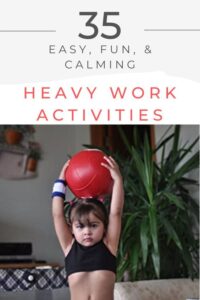
The secret is out! Discover 60+ sensory diet activities that can easily be integrated into your family’s routine. These activities are designed to motivate, engage, and make your child’s sensory diet fun! This post was created by Marra Robert, OTD, OTR/L, and contains affiliate links.

Are you looking to implement a sensory diet into your child’s routine? Or, maybe you already have a sensory diet in place for your child and are interested in switching up the activities to increase motivation and fun. Well, if that’s the case, you’ve come to the right place.
Hi! My name is Marra, and I am a mom and a pediatric occupational therapist who spent years working with children with sensory processing difficulties.
I worked closely with children and their families to develop and assess an individual sensory diet that met the child’s needs and fit into the family’s already established daily routine so that it was easy to follow and, in the end, decreases the overall stress for the child and the family.
Before we start talking about sensory diet activities, we first need to understand sensory processing and sensory diets.
What is Sensory Processing
Everyone processes sensory information all the time, day and night. We take in all of the information from our environment through our 8 senses, process it and try to make sense of it, and then we choose an appropriate response.
A lot of the time, we have to decide what information to pay attention to and what to ignore. For some of our children, this is really challenging for them.
Children who have difficulty processing sensory information will have difficulty choosing an appropriate response, whether that’s behavioral or emotional. If you would like to learn more about sensory processing, check out What is Sensory Processing?

What is a Sensory Diet?
Some children need more or different types of sensory input in order to help keep their bodies and minds in a calm, organized state where they can best learn, play, and be themselves.
A sensory diet is a preventative strategy that provides a small “snack-like” sensory input through different activities to help keep them in this state and to prevent them from reaching a dysregulated and disorganized state that is challenging to recover from.
It’s important to remember that sensory diet activities are used as a preventative strategy, and children should participate in them frequently throughout the day instead of only when they need a sensory break.
If you’d like to learn more about sensory diets, their benefits, and how to develop a sensory diet that fits into your family’s schedule, check out Sensory Diets: Understanding the Basics and Benefits

THINGS TO REMEMBER WHEN ADDING NEW ACTIVITIES TO A SENSORY DIET
It’s very important never to force your child to participate in a sensory activity they don’t want to do. If the child is frustrated or upset, the activity will not help accomplish the goal of helping to calm and regulate their nervous system.
At the end of the day, no one, except that child, truly knows how their body is feeling or how an activity makes them feel, and we need to respect that.
The activities are intended to be fun and engaging for the child. This is why I’ve provided such a long list of activities so that you will have plenty of options depending on your routine and your child’s interest.
Remember that the end result of implementing a sensory diet is to help make life a little easier for your child and your family, so choose activities that fit well into your already-established family routine
If you try a new sensory diet activity with your child, that upsets them or increases their hyperactivity, or does the opposite of what it’s attended to do, try a different activity. I
t’s important to note that children’s sensory needs vary from day to day, so it is important that your child’s sensory diet is flexible and has room to change based on their needs as well.

CONSULTING WITH A PEDIATRIC OCCUPATIONAL THERAPIST
Every child is different and has unique sensory needs. Working with a pediatric occupational therapist when developing a sensory diet for your child is so important.
A pediatric occupational therapist is a licensed healthcare professional who takes a holistic, client-centered approach to health and well-being and focuses on helping children meet their goals and increase participation in meaningful activities.
An OT can help you develop a sensory diet that is tailed to your child’s needs. Many sensory activities can be added to your child’s sensory diet. They are grouped by sensory need or input.
OBSTACLE COURSES
Obstacles courses are one of my favorite sensory activities because they provide children with various sensory input and strengthen their ability to integrate sensory input from different sensory systems. You can include so many different activities in the obstacle course, such as:
-
- Walking over couch cushions (if you are ok placing them on the floor)
-
- Climbing up on the couch and jumping down
-
- Hopping on one foot

PROPRIOCEPTIVE SENSORY DIET ACTIVITIES
These activities will provide your child with proprioceptive or deep pressure sensory input, which will help calm their nervous system and help them process all of the sensory input they get throughout their days. As an added bonus, these activities also work on improving their body awareness.
- Jumping on a trampoline
- Wall push-ups: Have your child stand arm’s length from the wall with their palms on the wall, lean while bending their elbows until their nose touches the wall, and then push off of the wall until their arms are straight.
- Chair or regular push ups
- Pulling on a rope attached to a door or a heavy object. You can even play tug-o-war with your child.
- Gym Playset for Children
- Ball pit
- Supported headstand: Make sure your child is strong enough to safely do this.
- Deep-pressure massage. Many of the children I worked with loved deep pressure massage. You do not have to be a professional or know any techniques just keep the massage strokes slow and apply a lot of pressure as you do it.
- Squeezes; Some children love hugs, some like shoulder squeezes, and some love having their feet squeezed. Just experiment and see what your child likes.
- Jumping on one foot
- Going for a run
- Weighted blanket
- Weighted stuffed animal
- Yoga: You can use these cards I have linked here, or you can make up your own yoga poses with your child.
- Going for a walk with a heavy backpack
- Exercises with theraband
- Theraputy
- Carrying in groceries
- Pushing a heavy laundry basket full of laundry or toys
- Rolling a peanut ball over their back while they lay on their stomach
- Animal walks
- Playing with squigz
- Pull tubes
- Climbing jungle gyms or play structures at the park
- Monkey bars
- Squishes with bean bags
- Jumping on a crash pad or cushions
- Taking deep breaths
- Blowing bubbles
- Blowing cotton balls across the tables
- Blowing Pinwheels
- Wearing tight clothes
- Wearing a compression vest
- Heavy work activities

SENSORY DIET ACTIVITIES THAT PROVIDE MOVEMENT SENSORY INPUT
- Blanket swing
- Dancing
- Sit and spin
- Red light green light
- Balance beam
- Rolling up in a blanket
- Exercises on a yoga ball
- Swings
SENSORY DIET ACTIVITIES THAT PROVIDE TACTILE SENSORY INPUT
- Dried Fruit
- Chewy tubes
- Chewy Jelwry
- Face massage around the jaw
- Brushing teeth with an electric toothbrush
I hope you have fun exploring different sensory diet activities with your child. Please leave a comment below with
